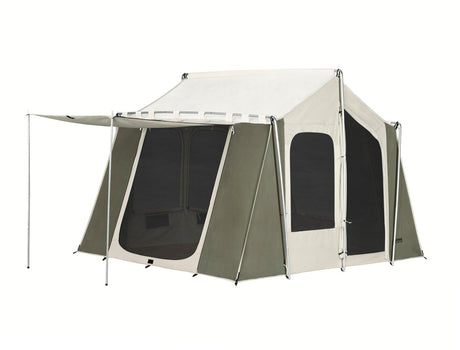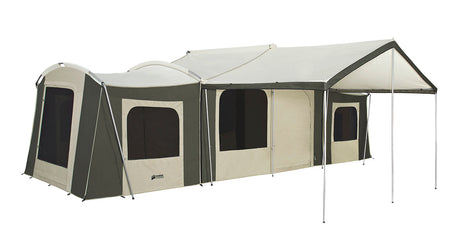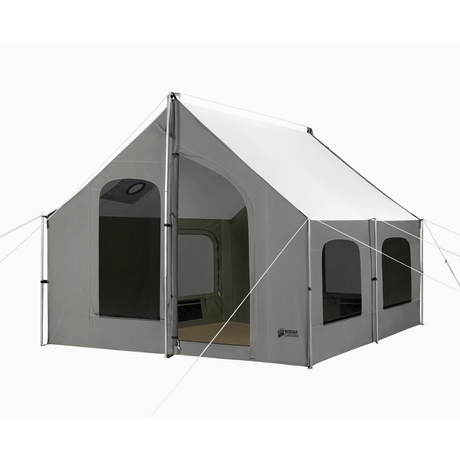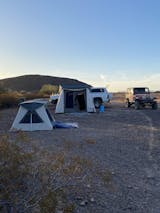Kodiak Canvas
12 x 9 ft. Canvas Cabin Camping Tent with Deluxe Awning
$879.99Unit price /UnavailableKodiak Canvas
26 x 8 ft. Grand Cabin Canvas Camping Tent with Awning
$999.99$1,799.99Unit price /Unavailable
Benefits of a cabin style tents:
A cabin style tent is a type of camping tent that typically has straighter walls and a higher ceiling than traditional dome-style tents. Some of the benefits of a cabin style tent include:
- More Headroom: With a higher ceiling, cabin-style tents provide more headroom, making it easier to move around inside the tent. This is especially useful for taller individuals or families with children who may need more space to stand or move around.
- Increased Floor Space: The straight walls of cabin-style tents offer more usable floor space compared to the sloping walls of dome-style tents. This means you can fit more people or gear inside the tent without feeling cramped.
- Better Airflow: Cabin-style tents often have multiple windows and doors, which can provide better ventilation and airflow. This can help keep the interior of the tent cooler and more comfortable, especially on hot days.
- Improved Privacy: Cabin-style tents often have room dividers or separate sleeping areas, which can provide more privacy for individuals or families camping together.
- Easy Setup: Many cabin-style tents have a simpler setup process compared to other types of tents, which can make them easier and faster to pitch.
Overall, cabin-style tents can offer a more comfortable and spacious camping experience, especially for larger groups or families.
Which material is best for a cabin tent?
When it comes to selecting the best material for a cabin tent, there are several factors to consider, including durability, weather resistance, weight, and breathability. Here are some of the most used materials for cabin tents:
- Canvas: Our Hydra-Shield™ cotton canvas is a heavy-duty fabric that is known for its durability and extreme water resistance. It is also breathable, which makes it a popular choice for camping in hot and humid climates.
- Polyester: Polyester is a synthetic fabric that is lightweight and easy to transport. It is also water-resistant and can withstand prolonged exposure to sunlight. However, polyester is not as durable as canvas and may tear or puncture more easily. It also doesn’t breathe like canvas, which may make it less comfortable to sleep in. The lifespan of a polyester tent is much shorter than the more durable canvas tents, so you need to consider total cost of ownership for the life of your tent, and future replacement costs.
- Nylon: Nylon is another lightweight and durable synthetic fabric that is commonly used for tent construction. It is water-resistant and can be treated with a coating to improve its UV resistance. However, nylon is not as breathable as canvas, which can make it uncomfortable to sleep in during hot weather and creates condensation inside the tent in colder weather.
Ultimately, the best material for a cabin tent will depend on your individual needs and preferences. Consider factors such as the climate you will be camping in (how critical is breathability?), durability, the weight of the tent, and the level of durability you require before making your decision.
If a canvas cabin tent is right for you, Kodiak Canvas has some wonderful options that will have you camping in style and comfort for years to come.
Introducing our new Cabin Lodge Stove-Ready Tents
When Kodiak Canvas set out to design our Canvas Cabin Lodge Stove-Ready Tents, we wanted to build the perfect replacement for the traditional wall tent. We wanted something just as durable and strong as a wall tent – and the ability to have a stove in your tent – but a canvas tent that solves the main complaints campers usually have about the wall tents – primarily, no floor (bugs, critters, wind, water), lack of ventilation, and portability (or the effort and space required to transport your canvas tent). We feel we’ve created the perfect replacement for the traditional wall tent. The Kodiak Canvas Cabin Lodge Stove-Ready tents are very similar to traditional canvas wall tents in size and shape, the primary difference being the Kodiak Canvas Lodge tents come with an integrated heavy-duty vinyl floor and six different windows with no-see-um mesh for ventilation. In a side-by-side comparison, we think you’ll find the Kodiak Canvas Lodge tents much more comfortable.
We’d like to call out the primary differences between a traditional wall tent and a Kodiak Canvas Lodge Stove-Ready tent:
- Kodiak Canvas Lodge Tent
- Integrated heavy-duty vinyl floor (keeps water, wind, bugs and critters out of your tent)
- 6 windows, one with a storm canopy
- Excellent ventilation
- Hydra-Shield Canvas isn’t treated with paraffin or oil – breathes much better
- Optional center support pole for heavier snow-loads
- Wall Tent
- Minimal windows if any
- No integrated vinyl floor – the ground is your floor (bugs and critters have easier access to anything stored inside your tent; both wind and water can find their way under the walls of your tent)
- Canvas is typically treated with paraffin or oils – doesn’t allow the canvas to breathe
- Frame is much heavier – takes more effort to transport and setup
Like the traditional canvas wall tents, the Kodiak Canvas Lodge tents are equipped with a stove jack for use with a wood burning stove inside the tent.





















